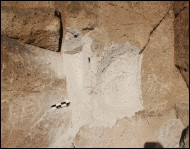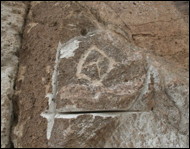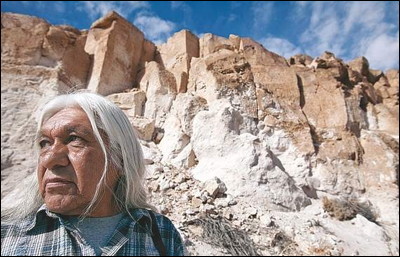Thomas Doty – Storyteller
News: Petroglyphs Stolen




Raymond Andrews, tribal historic preservation officer of the Bishop Paiute Tribe, visits the area near North Bishop, Calif., that is host to petroglyphs etched by ancient hunters and gatherers into the fractured volcanic cliff faces. Vandals removed at least four prominent petroglyphs with power saws and damaged several others.
Petroglyphs stolen in 'smash and grab'
By Louis Sahagun
Los Angeles Times
November 21, 2012
BISHOP, Calif. — Ancient hunters and gatherers etched vivid petroglyphs on cliffs in the Eastern Sierra that withstood winds, flash floods and earthquakes for more than 3,500 years. Thieves needed only a few hours to cut them down and haul them away.
Federal authorities say at least four petroglyphs have been taken from the site. A fifth was defaced with deep saw cuts on three sides. A sixth had been removed and broken during the theft, then propped against a boulder near a visitor parking lot.
Dozens of other petroglyphs were scarred by hammer strikes and saw cuts.
"The individuals who did this were not surgeons, they were smashing and grabbing," U.S. Bureau of Land Management archaeologist Greg Haverstock said last week as he examined the damage. "This was the worst act of vandalism ever seen" on the 750,000 acres of public land managed by the BLM field office in Bishop.
The theft required extraordinary effort: Ladders, electric generators and power saws had to be driven into the remote and arid high desert site near Bishop. Thieves gouged holes in the rock and sheared off slabs that were up to 15 feet above ground and 2 feet high and wide.
Visitors discovered the theft and reported it to the BLM on Oct. 31. BLM field office manager Bernadette Lovato delivered the bad news to Paiute-Shoshone tribal leaders in Bishop.
"It was the toughest telephone call I ever had to make," Lovato said. "Their culture and spiritual beliefs had been horribly violated. We will do everything in our power to bring those pieces back."
The region is known as Volcanic Tableland. It is held sacred by Native Americans whose ancestors adorned hundreds of lava boulders with spiritual renderings: concentric circles, deer, rattlesnakes, bighorn sheep, and hunters with bows and arrows.
For generations, Paiute-Shoshone tribal members and whites have lived side by side but not together in Bishop. But desecration of the site, which Native Americans still use in spiritual ceremonies, has forced reservation officials and U.S. authorities to come together and ask a tough question: Can further vandalism be prevented?
"How do we manage fragile resources that have survived as much as 10,000 years but can be destroyed in an instant?" asked archaeologist David Whitley, who in 2000 wrote the nomination that succeeded in getting the site listed on the National Register of Historic Places. "Do we keep them secret in hopes that no one vandalizes them? Or, do we open them to the public so that visitors can serve as stewards of the resources?"
The easy answer is to police the site and others listed under the Archaeological Resources Protection Act. But that's not possible given the condition of cash-strapped federal lands agencies, authorities said.
Authorities said the petroglyphs aren't worth a great deal on the illicit market, probably $500 to $1,500 each. But they are priceless to Native Americans, who regard the massive tableaux as a window into the souls of their ancestors.
The site is one of dozens of such locations managed by the BLM office in Bishop. A small army of volunteers has stepped up surveillance of the area.
For archaeologists, the images carved into a half-mile-long volcanic escarpment depict the culture and spiritual beliefs of the ancient tribes that once populated the sage flats and river valleys of the Eastern Sierra.
Paiute tribal historic preservation officer Raymond Andrews observed sacred law by quietly chanting a traditional prayer when he approached the site earlier this month.
Standing beneath a panel of geometric renderings believed to have been carved by shamans, Andrews took a slow, deep breath and said: "We still use this sacred place as a kind of church to educate tribal members and children about our historical and spiritual connections. So, our tribal elders are appalled by what happened here."
Federal authorities and Native American leaders plan to mark each defaced petroglyph with a small sign pointing out that, as archaeologist Haverstock put it, "this damage was done by malicious, selfish individuals."
The BLM is offering a $1,000 reward for information leading to the arrest and conviction of the thieves. Damaging or removing the petroglyphs is a felony. First-time offenders can be imprisoned for up to one year and fined as much as $20,000, authorities said. Second-time offenders can be fined up to $100,000 and imprisoned up to five years.
Photo Credits | Privacy | Donate
Website © 1997-
by Thomas Doty.
